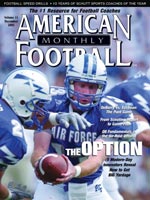AMERICAN FOOTBALL MONTHLY THE #1 RESOURCE FOR FOOTBALL COACHES
Article CategoriesAFM Magazine
|
From Scouting Report to Game Plan“Our editing system is a time saver and it gives us the ability to teach our kids more than just try to figure out what a team is doing without showing them. We can show them quickly. And we’re not spending hours doing as much video because we’re doing more teaching.”-John Troxell by: W. Keith Roerdink © More from this issue Know thy enemy. On the battlefield or the football field, few statements ring truer than that. Being able to effectively size up an opponent, identify their weaknesses, recognize their tendencies and formulate an attack puts you that much closer to victory on Saturday. In today’s high-tech world, scouting the opposition is often done with the latest in digital editing equipment. And when the lights go out, every program, every coach and every player is scanning their scouting report for the exact same thing: an edge. Jimmy Burrow, defensive coordinator at Ohio University under former Nebraska head coach Frank Solich, knows the value of a good scouting report. As a 20-plus year coaching veteran, he also knows the tedious work that was once involved in producing them. That makes his appreciation for their digital editing system ....The full article can only be seen by subscribers. Subscribe today!
|
|
|||||||
| HOME |
MAGAZINE |
SUBSCRIBE | ONLINE COLUMNISTS | COACHING VIDEOS |
Copyright 2025, AmericanFootballMonthly.com
All Rights Reserved





